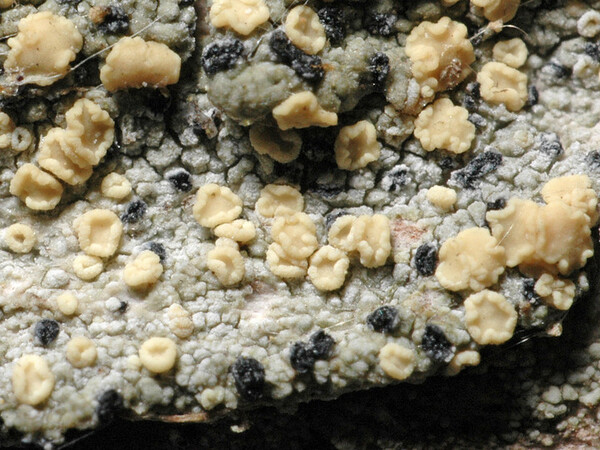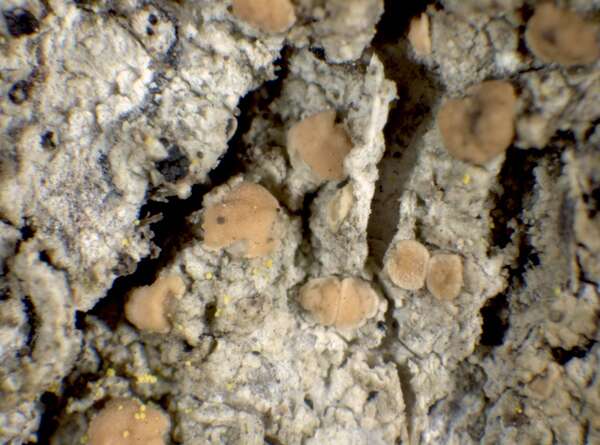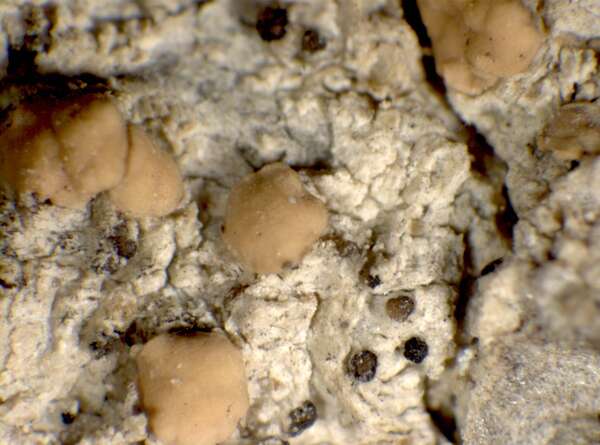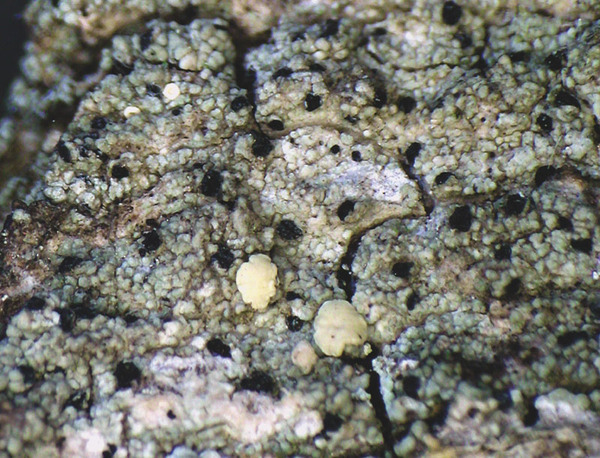Cliostomum corrugatum (Ach.) Fr.
Lichenogr. Eur. Ref.: 455, 1831. Basionym: Lecidea corrugata Ach. - Syn. Meth. Lich.: 18, 1814.
Synonyms: Biatora ehrhartiana (Ach.) W. Mann; Biatorina ehrhartiana (Ach.) Mudd; Biatorina graniformis (K.G. Hagen) A.L. Sm.; Catillaria ehrhartiana (Ach.) Th. Fr.; Catillaria graniformis (K.G. Hagen) Vain.; Cliostomum graniforme (K.G. Hagen) Coppins; Lecidea ehrhartiana (Ach.) Ach.; Rhytisma corrugatum (Ach.) Fr.
Distribution: N - Ven, TAA (Nascimbene & al. 2007b, 2014, Nascimbene 2014, Nascimbene & Marini 2015, Trindade & al. 2021), Lomb. C - Mol (Nimis & Tretiach 1999, Caporale & al. 2008), Sar (Zedda 2002, 2002b). S - Cal (Puntillo 1996).
Description: Thallus crustose, episubstratic, thick, continuous, areolate or coarsely warted, pale grey to yellowish grey, often with an oily shine, turning ochraceous in the herbarium. Apothecia rare, lecideine to biatorine, 0.4-1 mm across, with a concave to slightly convex, pale yellow to pale pinkish yellow, thinly pruinose disc and a thin, finally often excluded proper margin. Proper exciple of radially arranged hyphae, faintly purplish and often K+ violet in outer part, colourless and densely granular within, the granules soluble in K; epithecium colourless or pale yellow, often with granules; hymenium colourless, I+ blue; paraphyses mostly simple, with more or less clavate apices; hypothecium colourless. Asci 8-spored, cylindrical-clavate, the tholus with a conical, blunt, sometimes indistinct ocular chamber and a distinctly conical axial body, the remainder of tholus I+ dark blue, darkest around the axial body. Ascospores 1-septate. hyaline, narrowly ellipsoid, straight or slightly curved, 10-13 x 2-2.5 µm. Pycnidia abundant, projecting, fairly large, 0.2-0.6 mm across, black but often paler around the ostiole, widely gaping, irregularly shaped, becoming multilocular, the wall with a brown, K+ purplish pigment. Conidia ovoid to short-cylindrical, 2-4 x c. 1 µm. Spot tests: thallus K+ yellow, C-, KC-, P-. Chemistry: thallus with atranorin, apothecia with usnic acid. Note: a mainly cool-temperate species found on old oaks, but also on Abies in humid stands, more rarely on lignum (decorticated trunks, wooden poles), both in the Alps and in humid montane forests of the Peninsula. It is included in the Italian red list of epiphytic lichens as “Near-threatened” (Nascimbene & al. 2013c).
Growth form: Crustose
Substrata: bark and lignum
Photobiont: green algae other than Trentepohlia
Reproductive strategy: mainly sexual, or asexual by conidia and thalloconidia
Most common in areas with a humid-warm climate (e.g. most of Tyrrenian Italy)
Commonnes-rarity: (info)
Alpine belt: absent
Subalpine belt: absent
Oromediterranean belt: absent
Montane belt: extremely rare
Submediterranean belt: absent
Padanian area: absent
Humid submediterranean belt: extremely rare
Humid mediterranean belt: absent
Dry mediterranean belt: absent

Predictive model
Herbarium samples
Growth form: Crustose
Substrata: bark and lignum
Photobiont: green algae other than Trentepohlia
Reproductive strategy: mainly sexual, or asexual by conidia and thalloconidia
Most common in areas with a humid-warm climate (e.g. most of Tyrrenian Italy)
Commonnes-rarity: (info)
Alpine belt: absent
Subalpine belt: absent
Oromediterranean belt: absent
Montane belt: extremely rare
Submediterranean belt: absent
Padanian area: absent
Humid submediterranean belt: extremely rare
Humid mediterranean belt: absent
Dry mediterranean belt: absent

Predictive model
| Herbarium samples |
 Index Fungorum
Index Fungorum
 GBIF
GBIF








